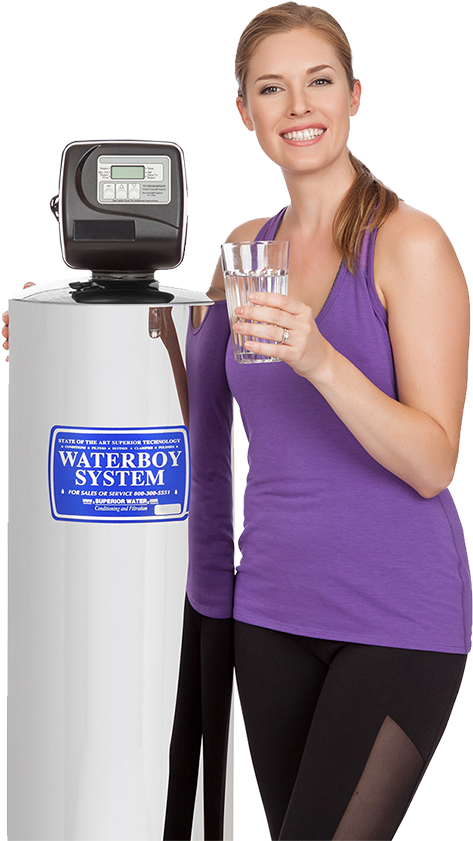What is the difference between the WATERBOY System and a salt or potassium soft water system?
The difference between the WATERBOY System and a salt-based system is that the WATERBOY system does not require any salt or chemicals. The disadvantage of a salt or potassium water softening system is that it addresses only one problem, and that is the hardness of the water. It does not filter the water. Salt based systems remove calcium and magnesium minerals and exchange them for sodium chloride or potassium chloride. The result is that there is salt throughout the house, which you have to shower or bathe in, as well as the additives the city puts in the water. Drinking the salt water is not recommended, so a reverse osmosis unit is usually installed to remove the salt. A salt system requires lugging bags of salt or potassium and/or having an exchange unit that requires service people to enter your property on a regular basis.
Another disadvantage that we hear from our customers, who have had salt systems, is that they have to replace their hot water tank every 3-5 years, due to corrosion. In addition, most softeners are being banned throughout California due to environmental issues. A water softener has to use salt to “regenerate” or flush out the built-up minerals in the resin tank sending high content sodium levels down the drain.
What kind of maintenance does The WATERBOY require?
There is no maintenance, no salt to add, and no media filters to change for about 10-15 years.
How does the back-wash control valve work?
The control valve automatically puts the unit into a back-wash mode once a week, about 10-15 minutes, which repositions all filtration media, washes out all of the filters, regrades the beds and goes out a ½ inch PVC line to a lawn, garden or drain.
Do I need a reverse osmosis unit in the kitchen sink?
The WATERBOY whole house system eliminates the need for any reverse osmosis unit, because there is no salt or potassium to remove. You can drink from every tap in the house, and it is a higher alkaline water than reverse osmosis, similar to mountain spring water. (Fluoride removal would be the exception).
What are some of the economic benefits of the WATERBOY whole house system?
- No salt or potassium to purchase.
- No maintenance costs.
- No reverse osmosis unit, which requires annual, costly filter changes. ($150-$200)
- Longer life for all appliances. (dishwasher, washing machine, hot water heater, etc.)
- Extended life of plumbing, no replacing of calcified pipes or faucets.
- No water loss from reverse osmosis unit. (they waste from 2 to 5 gallons for every gallon they make).
- No media filter changes for 10-15 years.
- No monthly rental charges.
- No bottled water purchases.
How long does it take to install a WATERBOY System?
A WATERBOY system takes 1-3 hours for a standard installation. Water and heater are turned off during installation.
How do you know when to change the filters?
The industry standard is that 1 cubic ft. (of granular active carbon) will effectively filter 1 million gallons of water.
For example, the WB2000 has 1 cubic ft. of granular active carbon. The Waterboy 2000 has 1.5 cubic ft. of granular active carbon and media filters . Since the WATERBOY 2000 will filter about 2.3 million gallons of water, filters would need to be changed between 12- 15 years based on number of people in the house using water.
What does the water taste like?
Superior water tastes like mountain spring water, because the minerals are left in the water, which gives it a very clean and flavorful taste. Many bottled water companies are adding minerals to their water to make it taste better. And for more vitality.
What is the pH of the water after the WATERBOY is installed?
The WATERBOY does not remove essential minerals from the water, so the PH remains the same. Most municipal water comes in at 7.0 PH neutral alkalinity.
Will the WATERBOY remove mineral build up?
When water goes up the multi reversing module, it will produce a more soluble mineral when it comes out of the tank into the home. It will be easier to clean, and less hard spotting occurs. The WATERBOY will also reverse hard water build up in pipes and appliances.
Why does the WATERBOY have to backflush?
The patented control valve automatically puts the unit into a back-wash mode once a week, for about 10-15 minutes, washes out all of the filters, regrades the beds and goes out a 1/2-inch PVC line to a lawn, garden or drain. This process extends the life of the WATERBOY system.
Where does the unit get installed?
Most units are installed on the main water line, after the PRV (pressure regulator valve) which is usually in the garage, or on the side of the house. The plumber will work with the customer to assess the best place for installation and where the backflush line will empty to.
What is the WATERBOY tank made of?
The WATERBOY tank is made of a structural high-performance vessel which is guaranteed to provide years of dependable service. The exterior jacket is made of durable stainless steel.
More questions?
We’d love to help!
Find more information here and on our FAQ page, or contact us and speak to one of our Water Quality Specialists today!
Serving: San Diego, Orange County, Los Angeles, San Fernando Valley, Riverside County Inland Empire and the surrounding areas.

Email Us:
ad***@su***********.com

Call Us:
800 WATERBOY or 800-300-5551


![3670104[1]](https://superiorwater.com/wp-content/uploads/2021/03/36701041-150x150.png)
![WQA[1]](https://superiorwater.com/wp-content/uploads/2021/03/WQA1.png)
![bbb-accredited-business-symbol-png-logo-17[1]](https://superiorwater.com/wp-content/uploads/2021/03/bbb-accredited-business-symbol-png-logo-171.png)
![800px-Flag_of_the_United_States[1]](https://superiorwater.com/wp-content/uploads/2021/03/800px-Flag_of_the_United_States1.png)